“No man may indeed become wise before he has had his share of winters in this world’s kingdom.”—Author: Unknown (Date: Impossible to Determine).
The moment I read that out of an incredibly old selection of British literature in graduate school, I knew it would hold weight when I occupied a position in which I could help people. I had not yet begun Jiu-Jitsu nor was I using StrongFirst principles to train my combat athletes. At the time, I didn’t take anything but literature seriously. I had no idea that the meaning of these words would surface as a result of a global pandemic or that a unification of literacy and strength would help a community of athletes retain resilience on the field and achieve success in the classroom. As the pandemic disarmed the planet of its perceived conventional itinerary, structure, social gathering, and conception of the way we live(d), a new host of problems fractured the established manner of people’s approach to strength, education, and perseverance through devastating conflict.
As an educator in a Title I district (the U.S. Department of Education’s federally funded program that provides over seven billion dollars for schools with students at risk of failure or those in/near poverty), I saw the firsthand effects of the pandemic. Nearly school-wide malaise, a clear lack of effort, and physical activity reached a concerning low among students, especially those not enrolled in team sports or on teams that held less prestige than others (high school varsity as opposed to middle school teams). Although this was, and still is, a rippling concern nationwide, it felt particularly devastating. My own childhood and adolescence were cultivated in a similar milieu, and I know firsthand how difficult it can be to access physical training resources even without a global pandemic. The shadow of poverty and lack of resources present are barriers enough. To galvanize students to prioritize their own physical and academic strength, I needed to lean on what set me on the trajectory out of unfortunate circumstances—the unifying of physical and academic strength.
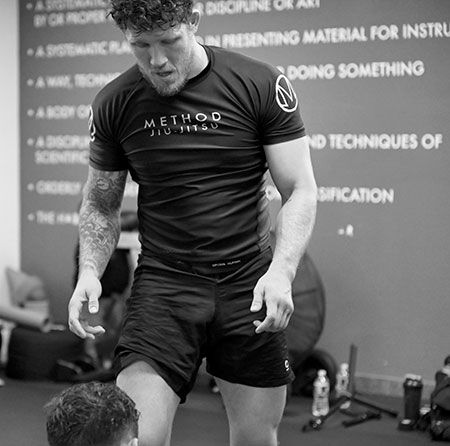
Strength and Literature
My own conception of the greater purpose of strength, as well as the unifying of literature and strength was born from a combination of wrestling and reading The Narrative of the Life of Frederick Douglass by Frederick Douglass. My strength and conditioning training as a high school wrestler followed what I now know as “greasing the groove.” In between episodes of WWE Raw and Smackdown on Monday and Thursday nights, I would alternate bodyweight movements (sit-ups, pushups, pullups on door frames, and any/every bodyweight movement I could think of) with the academic drill of reading several pages of The Narrative of the Life of Frederick Douglass. This served me well in a short high school wrestling career, while building my vocabulary and writing skills. I did not know I would later use this to build and maintain strength for the sport of wrestling and the challenge of university. Prior to attending university at 18, I had very few resources. I didn’t have access to a computer, so I was not able to learn how to properly use one until I attended college. I also went from training with minimal equipment to having full access to the university weight room. Ironically, with more options training became more complicated. Not only through the amount of equipment available, but also online sources that clouded the simplicity of training and studying.
Enter StrongFirst
The motivation to earn my rank as a StrongFirst Instructor came from my appreciation of minimalist training. I have never experienced better training than when I had only my body, a doorframe, and the library. Becoming a Certified StrongFirst Instructor led not only to understanding the kettlebell as a tool with many paths to strength, but also introduced me to StrongFirst programming. I took protocols like ladders and applied them to minimalist training—training that led to my half-bodyweight press at the SFG II in just a few months. My program consisted simply of heavy military press ladders and my accessory work was reading (two presses, two pages read, five presses, five pages read). I read in between ladders until my heart rate dropped as close to resting as possible.
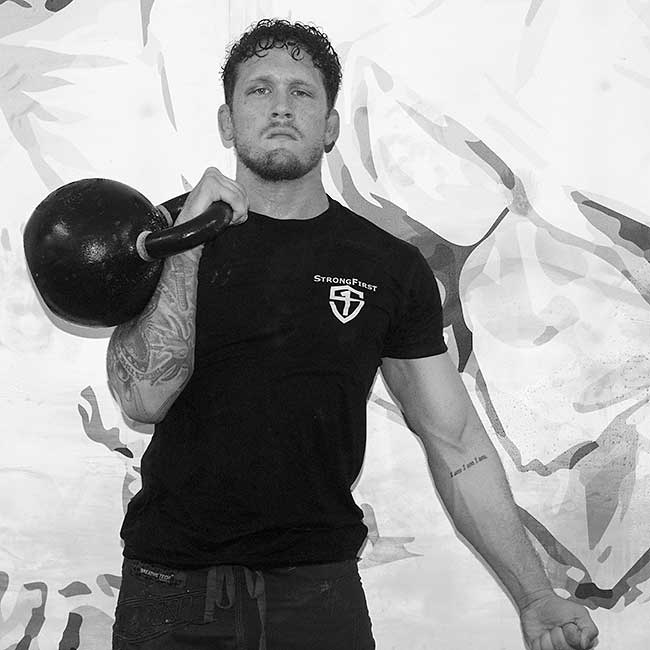
In addition to training protocols, the philosophy of StrongFirst resonated with me. Steve Milles, StrongFirst Certified Senior Instructor, urging us “not drink and study our manuals” during our certification weekend had shades of Douglass’s message from The Narrative of the Life of Frederick Douglass, when he protested indulging in alcohol due to its promotion of complacency. This view of training as a pathway to strength but also the discipline of the mind was influential and mirrored what I had learned in my early training years. After earning my title as an SFG II, I scrambled to contact parents in Roselle, informing them that over the summer their kids could receive free, well-programmed offseason training. This summer program would not only decrease the risk of soft tissue injury by prepping tendons to absorb and utilize elastic energy more efficiently for their return to the field, but also ensure that they retain their academic acuity for their return to the classroom.
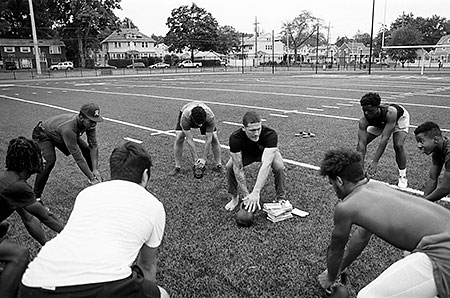
Following a strength and skill assessment in which the swing, clean, press, and squat were covered extensively, our call to arms took place several times a week on the turf where the football team practiced. Nearly all the ten to fifteen students that showed up and became technically proficient in kettlebell skills were former students; kids I had not seen since they were in my 8th grade classes. They were fighting not only to build and maintain strength for their sports, but also building and maintaining an economy of words and writing strategies to ensure their classroom success was paired with their athletic ability. The offseason saw us work through 100+ degree days, applying the same skills each session until movement quality improved. Our small group contained football, basketball, soccer, and baseball players all working steadily towards sharpening movement quality in their sport and building the baseline strength needed to perform well throughout their season.
The Program
Below is a sample of one week of training. During these three days, we followed the Rite of Passage style ladder from Enter the Kettlebell by Pavel. Although the program calls for pullups as an accessory movement, we didn’t have access to a pullup bar, so we included sport specific movements instead.
Day 1
- Movement Preparation
- Diagonal Band Pull-Apart: 2 minutes per side
- Goblet Squat: 2 minutes hip pry for 10 seconds at the bottom of each squat
- Overhead Single-Arm Carry while Reading: 2 minutes then grab a partner and explain the main idea of the paragraph to them
- Sport Specific Activation
- Vertical Jump: 10×1
- Sprints: 10×10 yards
- Work
- 3 Ladders, 5 Rungs (at the end of every rung, read designated number of paragraphs i.e., complete rung 3, read 3 paragraphs)
- Main Movement: One-Arm KettlebellMilitary Press
- Accessory Movement: Sled Drag (Distance = Rung number multiplied by 10. Rung 3×10 = 30 Yard Sled Drag)
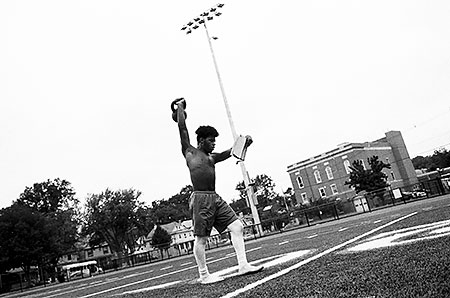
Day 2
- Movement Preparation
- Diagonal Band Pull-Apart: 2 minutes per side
- Goblet Squat: 2 minutes hip pry for 10 seconds at the bottom of each squat
- Overhead Single-Arm Carry while Reading: 2 minutes then grab a partner and explain the main idea of the paragraph to them
- Sport Specific Activation
- Broad Jump: 10×1
- Sprints: 3×20 Yards
- Work
- 4 Ladders, 3 Rungs (at the end of every rung, read designated number of paragraphs i.e., complete rung 3, read 3 paragraphs)
- Main Movement: One-Arm KettlebellMilitary Press
- Accessory Movement: Kettlebell Squat (mandatory two second pause at the bottom)
- Finisher: Roll 2 Dice for Kettlebell Swings (talk test determines rest and work periods)
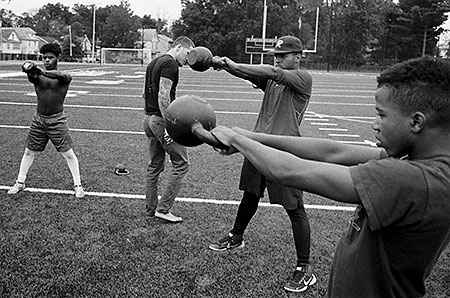
Day 3
- Movement Preparation
- Diagonal Band Pull-Apart: 2 minutes per side
- Goblet Squat: 2 minutes hip pry for 10 seconds at the bottom of each squat
- Overhead Single-Arm Carry while Reading: 2 minutes then grab a partner and explain the main idea of the paragraph to them
- Sport Specific Activation
- Light Double Kettlebell Weighted Vertical Jump: 8×1
- Sprints: 10×10 Yards
- Work
- 5 Ladders, 3 Rungs (at the end of every rung, read designated number of paragraphs i.e., complete rung 3, read 3 paragraphs)
- Main Movement: One-Arm KettlebellMilitary Press
- Accessory Movement: Sled Drag (Distance = Rung number multiplied by 10. Rung 3×10 = 30 Yard Sled Drag)
- Finisher:Roll 2 Dice for Kettlebell Swings (talk test determines rest and work periods)
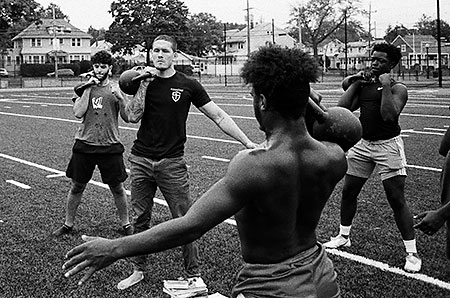
The Greater Purpose of Strength
Prior to this program, my kids had lost some movement quality and sport-specific skill training as the Roselle district does not have middle school teams—only county specific teams that are available for a cost. Because of this, even if students are lifelong admirers of a sport, they don’t have the privilege to take the field until they are fifteen years old. I began this program knowing that not many students in the small city of Roselle are able to play on paid teams, much less pay for training to support their skill development and physical preparation for their season. This was also compounded with the need for cognitive preparation in the most important academic years of their lives. Helping them build habits and understand methods and strategies to navigate grade level work was an important piece of their training. Both their physical and academic needs were covered by simple StrongFirst principles, paired with the understanding that literacy is just as much a rebellion as building strength in the fight against weakness and wasting time, effort, and life. As students return to the classroom, I am currently applying the same principles by teaching offseason Jiu-Jitsu and “greasing the groove” using grade level novels as a tool—rest time is reading time. In remembering that hundred-years-old quote discovered by a 21-year-old version of myself, only recently removed from the same social and academic predicament as my students, I have come to find the true value of these words:
“No man may indeed become wise before he has had his share of winters in this world’s kingdom.”
Our winter was the summer spent together on that field. It was our 100-degree winter with the intersection of physical and academic strength, creating good learning habits, strength, conditioning and, in turn, the resilience to find the greater purpose of true strength.
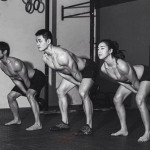
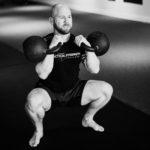
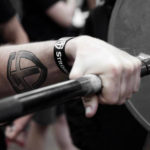
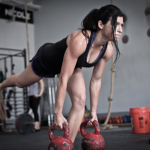
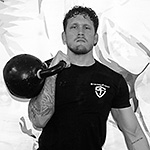

Very impressive approach and laudable commitment. I’m sure some of those students will keep in touch with you for many years to come.
Thank you for doing what you are doing with these kids. It goes far beyond strength training. Really inspirational. Be strong to be useful!
Thank you, Dave. As our kids move beyond high school, the community in strength we have created establishes a pretty cogent understanding of what the application of strength can do regardless of whether they pursue athletics at the university level or become productive professional components of our community. It means just as much to have the experience of having my students help my son and I out at the supermarket, restaurant, or tool shop as much as it is great to see them on the field at the NCAA level. The principles of strength in character are universal.
I would love to do something like this in my community. Did you make an up-front investment in all those kettlebells (15 students—that’s a lot of bells)? This is the main thing that has held me back this far from starting a KB community of my own.
And how did you decide what weight to use for high-school aged students? It seems that would be a challenge, wanting to ensure safety for those less conditioned while challenging the more conditioned.
Thanks. Loved this article and approach.
I began using kettlebells in my training for wrestling and combat sports in 2016, and have thrifted and saved for all of the kettlebells I have since then, so I just bring what I have to each session. But, more than deciding on the weight to use for the less conditioned or more conditioned is having everyone understand why we are working in this manner, and having true principles in terms of what qualifies someone to be able to work with our group (being on time, helping others, working at the corrective intensity for their ability). We spent a long time sharpening skills before more intense sessions came (the reason I got my SFG I was to just ensure I was doing my students a true service and not just throwing weight around). but even then, I work with everyone in my group in the classroom, on the wrestling mat, and on the field, so gauging appropriate intensity is much less difficult when you are an integral part of their total development. Good luck!
Brilliant! It is obvious you love your students! Keep on doing this!
Every day! Thank you for reading!
Absolutely beautiful article and description of what you’ve done! (It sort of makes me think of chess boxing.) Nice work all around!!
Excellent article and a unique perspective. Thank you for this. It’s truly incredible what you are doing for these students. I wish I’d had a teacher like you when I was in school 40+ years ago! Your program is well-crafted, and the addition of reading is an interesting and enriching component.
Hey,
Thank you so much for taking the time to read this article. I appreciate your kind words, and we work so hard in and out of the classroom that a lot of times it is tough to discern where the real learning is coming from in a day. Unifying them has changed my life, and maybe some of theirs, too. Thank you again!